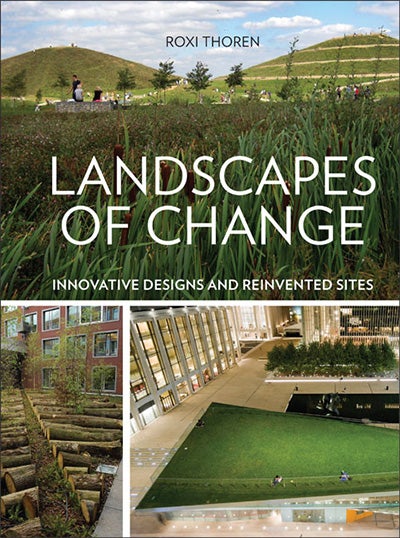Climate change, population shifts, and many other factors have changed the demands we place on landscape designs. Projects now have to absorb stormwater, cool urban centers, connect neighborhoods, and provide wildlife habitat. Landscapes of Change: Innovative Designs for Reinvented Sites, a new book by UO landscape architecture Associate Professor Roxi Thoren, examines how these challenges drive the design process, inspire new design strategies, and result in innovative works that are redefining the field of landscape architecture.

Above: Associate Professor Roxi Thoren
The Dirt blog, published by the American Society of Landscape Architects, named Landscapes of Change as one of the top ten books of 2014.
In twenty-five case studies from twelve countries, Thoren explores how sites serve as design generators. Each groundbreaking project is described in terms of the physical, material, ecological, and cultural processes that have shaped the site historically and continue to shape it. The book is organized by theme—infrastructure, postindustrial landscapes, vegetated architecture, edible landscapes, and ecological urbanism.
Most of the chapters began as lectures in Thoren’s seminar on landscape urbanism.
“This book is much richer than it might have been if I taught somewhere else, because in addition to my own research, it draws on my colleagues’ deep expertise in issues like agriculture and climate change,” Thoren says. “Our department has always studied and taught sustainability, long before that was a term, and each chapter touches on an issue that is fundamental to us, such as ecological urban design or agriculture in the city.”
The book is organized around sites and tactics; each of the five chapters explores a type of site that has challenged the design professions in recent decades, and the case studies reveal different tactics that designers have developed in response. Some of the chapters study physical sites, such as former factories, and others study conceptual sites, such as agriculture.
“It’s not that landscape architects are designing farms or farming processes, but that they are including agriculture in their designs for schools or neighborhoods,” Thoren says. “To use the example of agriculture, some projects are green roofs, others are in-ground; some are permanent, others are ephemeral; some are modular systems, others are unique to their sites. Each chapter presents a significant change in the context of our profession, and I chose projects that would show the reader a wide range of creative responses.”
The book’s case studies include Queens Plaza in Queens, New York; the Buffalo Bayou Promenade in Houston, Texas; and the Jaffa Landfill Park in Tel Aviv, Israel, among others.
“I find the neighborhood or regional scale projects especially compelling,” she says of the case studies, “like the Kokkedal Climate Adaptation Plan, a design for a Copenhagen suburb that uses the increased flooding projected from climate change as a catalyst for a more beautiful, educational, and socially just city. Or the Lone Star Coastal National Recreation Area, which proposes recreational landscapes along the Galveston Coast as a first line of defense against increasingly frequent hurricanes.”
Publishers Weekly said about Landscapes of Change that, “In a time of global urbanization, ecological degradation, and human disconnect from natural systems, this encouraging book examines how cutting-edge 21st-century landscape designers are drawing on disciplines of art, science, and city planning to create useful, livable landscape designs that delightfully enhance urban life.”
Landscape architects “are trained with an interesting set of skills,” Thoren observes, which meld art and science within a cultural context.
“We see shifts in the environment, and we design cultural responses to those shifts. Climate change is stressing our built environment in unprecedented ways. As designers, we need to work with scientists—ecologists, climatologists, hydrologists—to understand the processes at work. And we need to work artfully, and often with artists, to make places that are beautiful and culturally relevant. For me, that’s what sustainability is—living within an environmental context that you understand, in a way that is culturally fulfilling and inspiring.”
The 256-page book, with 225 color photos and illustrations, was published in December by Timber Press.
Thoren teaches in the departments of architecture and landscape architecture at UO and serves as director of the Fuller Center for Productive Landscapes. She holds master's degrees in architecture and landscape architecture from the University of Virginia. A Fulbright Fellow (Iceland) and a Landscape Architecture Foundation research fellow, Thoren has received research and design awards from the Council of Educators in Landscape Architecture, the American Society of Landscape Architects, and the Council of Landscape Architectural Registration Boards.

